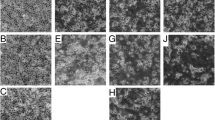Summary
Bluetongue virus multiplied in cell lines derived fromAedes albopictus andAedes pseudoscutellaris cells. Virus reached a maximum titre in theAe. pseudoscutellaris cells three days post inoculation, and inAe. albopictus cells six days p. i. Virus growth was demonstrated in both cell lines at 27° C and 37° C. Significant titres of virus were still present in theAe. albopictus cells after five subcultures at 27° C over a period of six weeks. No cytopathic effect was observed in either cell line.
A third cell line derived from the mosquitoAe. aegypti did not support the growth of Bluetongue virus.
Similar content being viewed by others
References
Brown, J. G., Jochim, M. M.: 1. Cytopathologic changes and development of Inclusion bodies in cultured cells infected with Bluetongue virus. Amer. J. vet. Res.28, 1091–1106 (1967).
Buckley, S. J.: Susceptibility of theAe. albopictus andAe. aegypti cell lines to infection with arboviruses. Proc. Soc. exp. Biol. Med.131, 625–630 (1969).
Cory, J., Yunker, C. E.: Arbovirus plaques in mosquito cell monolayers. Acta virol.16, 90 (1972).
du Toit, R. M.: The transmission of Bluetongue virus and African horse sickness virus byCulicoides. Onderstepoort J. vet. Sci. & Anim. Indust.19, 7–16 (1944).
Enzmann, P. J.: Induction of an interferon like substance in persistently infectedAe. albopictus cells. Arch. ges. Virusforsch.44, 382–389 (1973).
Howell, P. G., Verwoerd, D. W.: Bluetongue Virus. In: Virology monographs, Vol. 9, 35–74. Wien - New York: Springer 1970.
Luedke, A. J., Jochim, M. M., Jones, R. H.: Bluetongue in Cattle: Viraemia. Amer. J. vet. Res.30, 511–516 (1969).
Luedke, A. J., Jones, A. J., Jochim, M. M.: Transmission of Bluetongue between sheep and cattle byCulicoides variipennis. Amer. J. vet. Res.28, 457–460 (1967).
Luedke, A. J., Jones, R. H., Jochim, M. M.: The serial cyclical transmission of BTV in sheep andCulicoides varriipennis. Cornell vet.66, 536–550 (1976).
Mirchamsy, H., Hazrati, A., Bahrami, S., Shafyi, A.: Growth and persistent infection of African Horse Sickness virus in a mosquito cell line. Amer. J. vet. Res.31, 1755–1760 (1970).
Peleg, J.:In vivo behaviour of a Sindbis virus mutant isolated from persistently infectedAe. aegypti cell cultures. Ann. N.Y. Acad. Sci.266, 204–213 (1975).
Pini, A., Coackley, W., Ohder, H.: The adverse effect of some calf sera on the isolation and propagation of BTV in tissue culture: Arch. ges. Virusforsch.18, 89–95 (1966).
Nieschulz, O., Bedford, G. A. H., du Toit, R. M.: Investigation into the transmission of BTV in sheep during the season 1931–1932. Onderstepoort. J. vet. Sci. and Anim. Indust.2, 509–562 (1934).
Neitz, W. O.: Immunological studies on bluetongue in sheep. Onderstepoort J. vet. Sci. Anim. Ind.23, 93–136 (1948).
Neitz, W. O., Riemerschmid, G.: The influence of solar radiation on the course of bluetongue. Onderstepoort J. vet. Sci. Anim. Ind.20, 29–56 (1944).
Reed, L. J., Muench, H.: A simple method for estimating fifty percent endpoints. Amer. J. Hyg.27, 493–497 (1938).
Sinarchatant, P., Olson, L. C.: Replication of Dengue Type 2 inAedes albopictus cell culture. J. Virol.12, 275–283 (1973).
Singh, K. R. P.: Cell cultures derived from larvae ofAedes albopictus andAedes aegypti. Curr. Sci.36, 506–508 (1967).
Stollar, V., Shenk, T. E., Koo, R., Igarashi, A., Schlesinger, R. W.: Observations onAedes albopictus cell cultures persistently infected with Sindbis virus. Ann. N.Y. Acad. Sci.266, 214–231 (1976).
Suitor, E. C., Paul, F. J.: Synctia formation of mosquito cell cultures mediated by type 2 Dengue virus. Virology38, 482–485 (1969).
Varma, M. C. R., Pudney, M.: Growth and serial passage of cell lines fromAedes aegypti larvae in different media. J. med. Ent.6, 432–439 (1969).
Varma, M. C. R., Pudney, M., Leake, C. J.: Cell lines from larvae ofAedes (Stegomyia)Malayensis colless andAedes (s)pseudoscutellaris (Theobald) and their infection with some arboviruses. Trans. R. Soc. trop. Med. Hyg.68, 374–382 (1974).
Willis, N. G., Campbell, J. B.: Susceptibility of selected insect cell lines to the virus of Epizootic Haemorrhagic Disease of deer. Proc. of Third Internat. Coll. on Invert. Tissue Culture. Bratislava, 1971, 347–366. Bratislava: Publishing house of the Slovak Academy of Sciences 1973.
Author information
Authors and Affiliations
Additional information
With 1 Figure
Rights and permissions
About this article
Cite this article
Jennings, M., Boorman, J. The susceptibility of cell lines ofAedes aegypti (Linn.),Aedes albopictus (Skuse) andAedes pseudoscutellaris (Theobald) to infection with Bluetongue virus. Archives of Virology 59, 121–126 (1979). https://doi.org/10.1007/BF01317901
Received:
Accepted:
Issue Date:
DOI: https://doi.org/10.1007/BF01317901




